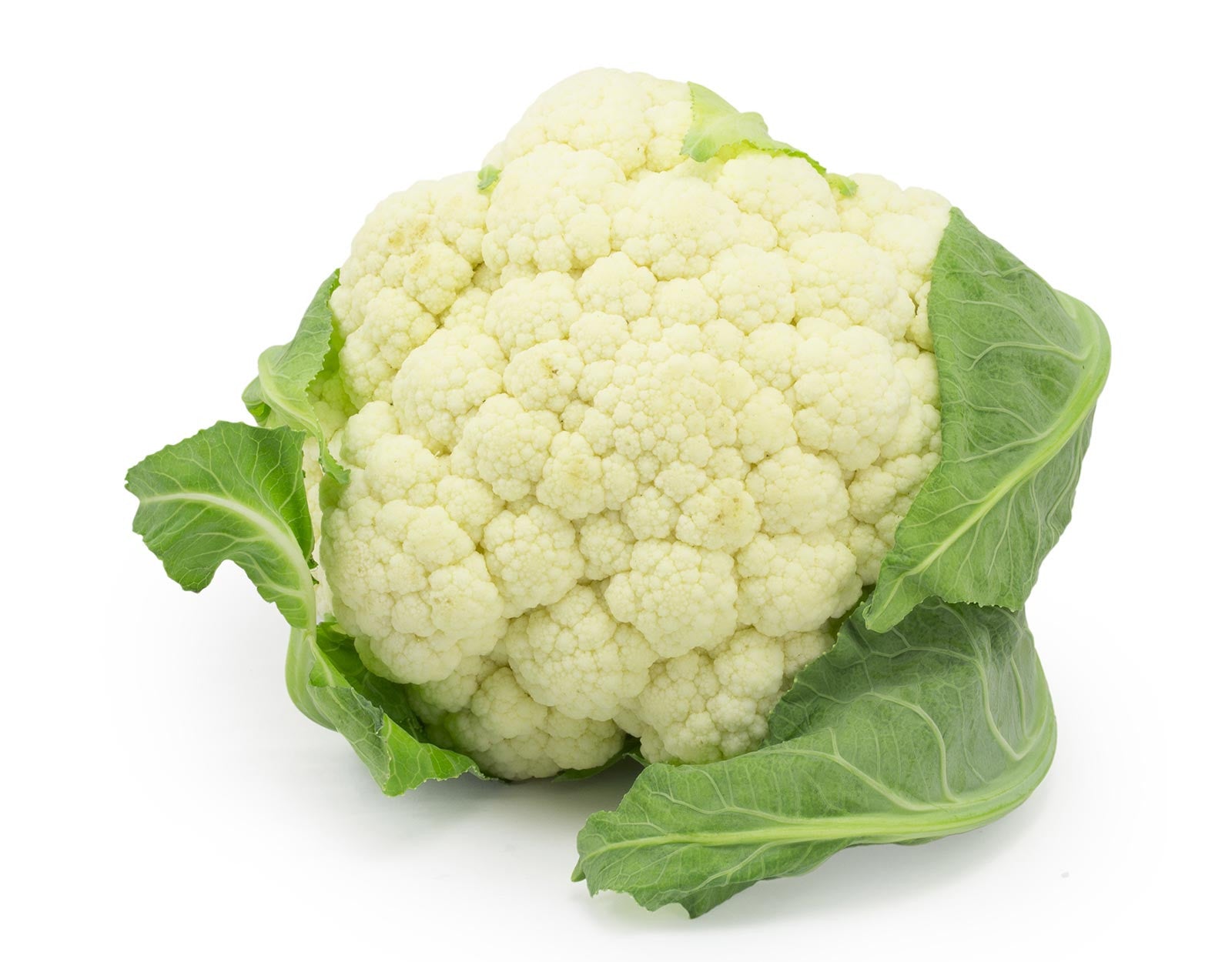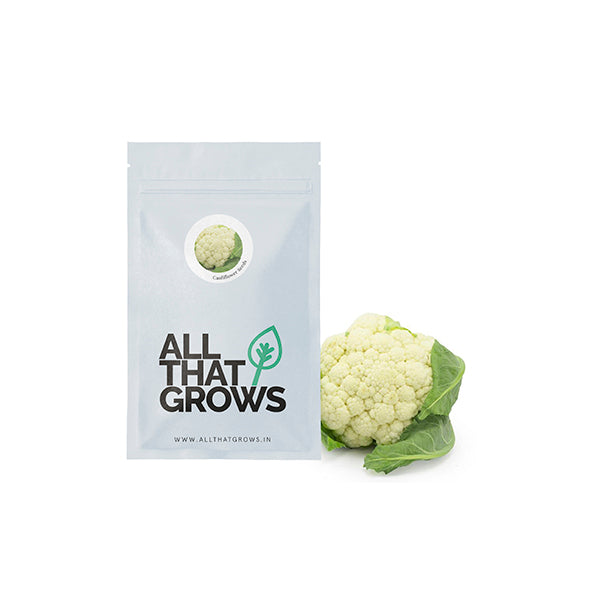



Cauliflower Seeds
Seed Type : Non-Hybrid, Open Pollinated and Non-GMO
Plant : Late maturity, winter hardy, excellent strain in Early to Late Snow Ball group
Curd Weight : 1.0 to 1.5 kg
Curd Shape : Dome
Harvesting : 90-95 days after transplanting
Specifications : Excellent self blanching leaf character which cover the curd upto 1.5 kg weight.
Sowing Time : September to November
- SOWING
TIMESep - Nov
- Sowing
DistancePlant to plant - 2'
Line to line - 2' - Fruit
Weight1.0 to 1.5 kg
- Fruit
ShapeDome
- Days to
maturity90-95 days
after transplanting
- Details
- How to sow
- Reviews
Cauliflower Rani or the white cauliflower is the most commonly found and grown variety in India and China. This is the variety that one can casually find in farmer's markets and regular vegetable displays. For us, Indians, the white cauliflower forms an important part of the staple vegetarian diet. The white variety is not only native to the Indian subcontinent and China but also found in Northern Europe, U.S and other countries. The white variety has a copious white curd and can be harvested after 90-95 days of transplanting. The white cauliflower is also quite versatile and can be eaten in a variety of ways which include fried, steamed, mashed, boiled, roasted, or simply cooked with other vegetables. It is as nutritive as the other varieties and is abundant in Vitamin C, K, and other essential phytochemicals. However, it does not contain the flavanoids and pigments like the purple variety and hence does not provide health benefits that the purple cauliflower does. All-in-all, it's a really great food to add to your diet!
If you are looking to add diversity and more healthful options in your kitchen gardens, then the white cauliflower makes a great addition.
Planting instructions
Soil needs to be very rich in organic matter. For that, you can add composted matter to the land before sowing cauliflower seeds.
It is best to sow cauliflower seeds indoors before transplanting. Transplant 2 to 4 weeks before the average frost date. Use a starter fertilizer while transplanting.
Space the transplants 18 to 24 inches apart with 30 inches of space rows.
In early spring, be ready to cover your plants. For fall crops, cover them if they require shelter from high temperature.
Add mulch to preserve moisture.
Growing Requirements
watering
They need 1 to 1.5 lites of water every week.
pests
Cauliflower is susceptible to the following list of pests that can cause excessive defoliation, mostly on the growing crop. Severe attacks can abort head formation, damage the heads and even lead to rotting. The pests that attack the crop are: Cabbageworm, Cabbage root maggots, Aphids, Harlequin bugs,Clubroot, Black rot.
soil
The crop prefers loamy soil with a pH that should range between 6.5 and 6.8
spot
Select a spot that receives at least 6 hours of sun.
temperature
Ideally, the daytime temperature while the cauliflower is maturing should be around 60ºF (15.5ºC).
how to harvest
When the heads are thick, clean, and firm, then it is the right time to harvest the cauliflower. Ideally, the heads will grow 6 to 8 inches in diameter.
Cut the heads off the plant with a large knife. Leave some of the leaves around the brain to keep it protected.
If the heads are small but have gone to open up, they will not improve and should be harvested.
If the cauliflower has a coarse appearance, it is overly mature and should be cast aside.
If you want to store cauliflower, you keep the head in a plastic bag. It should last about a week in the refrigerator.

Customer Reviews
The productiveness of any seed we sell is subject to your local climatic conditions*, the sowing method you adopt, and your commitment to the planting process. We give no warranty, expressed or implied, and are in no way responsible for the produce.
Please note that all our seasonal recommendations/ sowing information is as per the local climatic conditions. *For more information on the optimum conditions required for growing seeds in your region, please contact us at, hello@allthatgrows.in or Whatsapp us at, +91 8544865077
Questions & Answers
Have a Question?
Be the first to ask a question about this.




Cauliflower Seeds
Seed Type : Non-Hybrid, Open Pollinated and Non-GMO
Plant : Late maturity, winter hardy, excellent strain in Early to Late Snow Ball group
Curd Weight : 1.0 to 1.5 kg
Curd Shape : Dome
Harvesting : 90-95 days after transplanting
Specifications : Excellent self blanching leaf character which cover the curd upto 1.5 kg weight.
Sowing Time : September to November
Cauliflower Rani or the white cauliflower is the most commonly found and grown variety in India and China. This is the variety that one can casually find in farmer's markets and regular vegetable displays. For us, Indians, the white cauliflower forms an important part of the staple vegetarian diet. The white variety is not only native to the Indian subcontinent and China but also found in Northern Europe, U.S and other countries. The white variety has a copious white curd and can be harvested after 90-95 days of transplanting. The white cauliflower is also quite versatile and can be eaten in a variety of ways which include fried, steamed, mashed, boiled, roasted, or simply cooked with other vegetables. It is as nutritive as the other varieties and is abundant in Vitamin C, K, and other essential phytochemicals. However, it does not contain the flavanoids and pigments like the purple variety and hence does not provide health benefits that the purple cauliflower does. All-in-all, it's a really great food to add to your diet!
If you are looking to add diversity and more healthful options in your kitchen gardens, then the white cauliflower makes a great addition.
Seed Type : Non-Hybrid, Open Pollinated and Non-GMO
Plant : Late maturity, winter hardy, excellent strain in Early to Late Snow Ball group
Curd Weight : 1.0 to 1.5 kg
Curd Shape : Dome
Harvesting : 90-95 days after transplanting
Specifications : Excellent self blanching leaf character which cover the curd upto 1.5 kg weight.
Sowing Time : September to November
- SOWING
TIMESep - Nov
- Sowing
DistancePlant to plant - 2'
Line to line - 2' - Fruit
Weight1.0 to 1.5 kg
- Fruit
ShapeDome
- Days to
maturity90-95 days
after transplanting
Planting instructions
Soil needs to be very rich in organic matter. For that, you can add composted matter to the land before sowing cauliflower seeds.
It is best to sow cauliflower seeds indoors before transplanting. Transplant 2 to 4 weeks before the average frost date. Use a starter fertilizer while transplanting.
Space the transplants 18 to 24 inches apart with 30 inches of space rows.
In early spring, be ready to cover your plants. For fall crops, cover them if they require shelter from high temperature.
Add mulch to preserve moisture.
Growing Requirements
watering
They need 1 to 1.5 lites of water every week.
pests
Cauliflower is susceptible to the following list of pests that can cause excessive defoliation, mostly on the growing crop. Severe attacks can abort head formation, damage the heads and even lead to rotting. The pests that attack the crop are: Cabbageworm, Cabbage root maggots, Aphids, Harlequin bugs,Clubroot, Black rot.
soil
The crop prefers loamy soil with a pH that should range between 6.5 and 6.8
spot
Select a spot that receives at least 6 hours of sun.
temperature
Ideally, the daytime temperature while the cauliflower is maturing should be around 60ºF (15.5ºC).
how to harvest
When the heads are thick, clean, and firm, then it is the right time to harvest the cauliflower. Ideally, the heads will grow 6 to 8 inches in diameter.
Cut the heads off the plant with a large knife. Leave some of the leaves around the brain to keep it protected.
If the heads are small but have gone to open up, they will not improve and should be harvested.
If the cauliflower has a coarse appearance, it is overly mature and should be cast aside.
If you want to store cauliflower, you keep the head in a plastic bag. It should last about a week in the refrigerator.



 Sign In
Sign In








